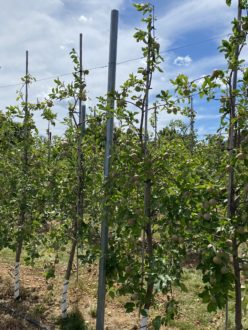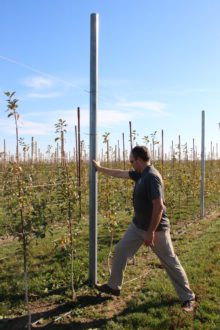Dec 12, 2022Trellis post options drive MSU research effort
The impacts caused by a faulty supply chain continue to bring significant challenges to agriculture, including tree fruit orchardists.
The need for alternative trellis materials took a serious turn more than a year ago when wooden posts used for high-density tree fruit systems were in short supply. The Michigan Tree Fruit Commission provided grant funds to Michigan State University (MSU) to establish demonstration trials on alternative materials at MSU’s Clarksville Research Center and the new West Michigan Research Station in Hart.


Other materials for posts may include metal, concrete, plastic or repurposed fiberglass.
Anna Wallis, apple production specialist for MSU Extension in the Grand Rapids region, is part of a project that seeks to identify trellis material options for growers. Wallis presented an update on the endeavor during grower field days in the summer and fall, the latter on Nov. 1 at the Hart facility.
“I’ve never done any engineering work before, but it’s been hugely important,” Wallis said. “We don’t have a magic answer for you yet. It’s been an ongoing process. The most recent development is we’re going to have a group of MSU students in the agricultural engineering program continuing to work on this.”
Wallis learned about the supply situation a year ago.
“Our supply chain has been disrupted in so many ways,” she said. “A lot of people couldn’t even get the wooden posts to install new trellises. They were hesitant to plant their orchards this spring. Planting a high-density tree requires support immediately. They needed a solution right away.”
Wallis said that for growers who could get them delivered, wooden posts have been expensive. “A lot of the wood had been converted into other building needs, especially as the housing market and other real estate buildings increased,” she said. “The cost of wooden posts, which historically has been much more affordable than any of the other materials, was really high.
“We started exploring other options,” Wallis said. “A couple of distributors of posts and other material came to us with other solutions. We filtered through a few of those and decided to evaluate some a little bit further.
“We compared everything to wood, which is the traditional material for posts, particularly red pine in this area,” Wallis said. “The things we did decide to evaluate included the cost of them, the strength of the materials in comparison to wood systems.”
Wallis said they worked with Mark DeKleine at (TrellX Anchoring Systems) to help evaluate these materials.


“He worked on such things as altering the spacings between trees so they would hold a comparable load. For example, the fiberglass is not quite as strong and can’t bear quite as heavy a load, so the spacing has to be a little bit closer.”
Wallis said plastic posts were eliminated because they are too flexible.
The researchers found that the fiberglass posts are “one of the more interesting materials that we’ve been looking at. These red fiberglass poles on the ground are something we’ve been looking at. They’re usually a refurbished material – hollow tubes that are used for applications like offshore drilling. When they are compromised in any way, like a pinhole in them or something, they can no longer be used for that application, so they’ve been repurposed for things like this.”
The 30-foot tubes were cut in half and installed in the high-density apple system. The new block consists of Aztec Fuji on Geneva 11, spaced 2.5 feet by 10 feet. It now has rows with fiberglass and steel posts, testing how well each holds up in high-density orchards.
The steel posts, manufactured by DeKleine, are used extensively in Washington, primarily because of cost, which includes the actual material and the shipping to get them here,” Wallis said.
The diameter and the thickness of each of the materials was analyzed. A design was developed based on the same number of wires, the equivalent loads that the system would be bearing and a recommended spacing for those materials.
Calculations were made based on the foot length of the rows. The system requirements are based on how many posts are needed based on the length of the row.
“The final material that we wanted to look at this year but couldn’t get is a cement post,” Wallis said. “We may be able to get some next year. They are manufactured in Italy. They are a proprietary product that have coiled wire on the inside that provides some flexibility and strength. Those are shipped from Italy and there is one distributor in the northeast. It requires some special handling because they are extremely heavy. We’re just learning about all of those factors.
“So far, we’ve seen that there are more comparable price points than what we expected because some of these materials are quite expensive,” Wallis said. “Considering the increase in cost of the wooden posts, they’re more comparable.”


MSU’s John Bakker, who had been the interim on-site manager at the Hart facility before retiring, has been involved in the trellis project.
“I was excited about fiberglass, mostly because of cost,” Bakker said. “We were told to put these at 12 or 16 feet. Based on the price of the material, that sounded like a good, solid alternative.”
A consideration to be further explored is how to attach wires to a non-wood post, Bakker said.
“With a wood post, you can pound a staple in or use other easy ways to attach your wires to that. How do we do that with fiberglass? We tried drilling holes, but they wore out the drill bits quickly. And beware of fiberglass getting splinters.”
Bakker said that based on some initial engineering work, there might be potential for putting them in the ground using cement-filled posts.
“I think that they’re some good alternatives here – some opportunities to do something other than wood,” Bakker said. “There’s more work to be done yet. Right now, I think we maybe have more questions than answers. And we don’t want to spend a lot of time and energy on materials that aren’t readily available.”
Daylong activities
The Tree Fruit Field Day at the West Michigan Research Station began with a morning pear meeting in which MSU entomology professor John Wise discussed biopesticide application methods to control pear psylla.
Participants learned about the latest research and viewed demonstration plots that have been established and efforts that are being made in borer research on stone fruit. Attendees heard about the current uses for the cooler rooms at the station.
Sessions were on farm stress and an update was presented by MSU Extension Tree Fruit Educator Emily Lavely regarding ongoing projects at the research center, which opened with grower and industry support in 2021.
MSU research assistant Cory Outwater gave an update on cherry leaf spot trials taking place at the center. In adjacent blocks, researchers compared fungicides Bravo and Initiate (chlorothalonil), captan and Kocide (copper hydroxide). Kocide, which they sprayed at 4 pounds per acre instead of the label-recommended 3.5 pounds, was the only product that provided season-long protection.
Outwater said that spraying Kocide at the higher rate provided greater control, though phytotoxicity did lead to some defoliation.
“The important thing is we are holding onto the majority of the leaf,” he said. “So, it might look really ugly early on. But it is controlling the disease.”
Trials and data collection will continue next year, Outwater said.
— Gary Pullano, FGN Senior Correspondent
Top photo: Growers are turning to alternative trellis materials due to the difficulty in obtaining wooden posts used for high-density tree fruit systems. Photos: Gary Pullano
Middle photo: An attendee checks the strength of a trellis post at a Tree Fruit Field Day Nov. 1 at Michigan State University’s West Michigan Research Station in Hart.
Bottom photo: Anna Wallis, right, an apple production specialist for Michigan State University (MSU) Extension in the Grand Rapids region, is part of a project that seeks to identify trellis material options for growers. Here, she makes a presentation at MSU’s Clarksville Research Center near Clarksville, Michigan.














